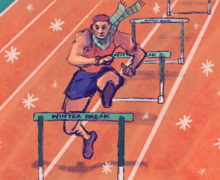Mind Games: Tom Clinton has given mental help for the past 17 years
The first real victory for Dr. Tom Clinton came in the fall of 1987. He was working as a graduate assistant at University College, organizing a course that taught life skills called Learning to Learn. One of the course’s instructors, Dr. James Duah-Agyeman, had an engagement and needed Clinton to fill in for him one day during a class.
As Clinton stood at the front of the room explaining how Los Angeles Laker Byron Scott used Neuro-Linguistic Programming – a behavioral technology that gives you the ability to choose your mental state of well-being – to lead the NBA in 3-point shooting, a booming voice came from the back of the room.
‘He didn’t lead the league in anything,’ shouted Syracuse forward Derrick Coleman.
At the front, SU guard Earl Duncan concurred. Clinton calmly put the issue aside, saying he would get back to them later.
So he found an NBA statistics book, photocopied the 3-point leaders in the 1986-1987 season – proving he was right – and quietly placed them on Coleman and Duncan’s desks before the next class.
Clinton insists it was a small confrontation, but it proved how sports psychology could be applicable at any level.
Knowing Clinton’s background as a basketball coach, Duah-Agyeman recommended that he meet with SU head coach Jim Boeheim to help remedy SU’s free-throw shooting. They met in summer of 1988 and Boeheim told him to come to practice. Clinton has been with the team’s unofficial sports psychologist ever since.
‘I tell players the night before a game, spend five or 10 minutes in visualization,’ Clinton said. ‘I have them talk to their position coach so they know what they need to work on, then I have them visualize a 35-second clip of being active and doing all the things they’re supposed to do.’
It’s difficult to measure the intangible success of Clinton’s help, but several NBA players have used Clinton’s techniques. Jason Hart, of the NBA’s Charlotte Bobcats, nicknamed Clinton ‘Doc’ when he was with the team in the late 1990s after using his help.
Clinton’s importance with the team is debated along with the usefulness of sports psychology in college athletics. On one hand, there are those with the old-school mentality that poor performance is simply bad execution on the playing field. On the other, a budding crop of sports psychologists is eagerly trying to prove the practice’s worth with universities around the country.
‘Some guys benefit from it, some guys don’t,’ said Mike Hopkins, SU assistant coach and one of the first players Clinton worked with when he joined the team in 1988. ‘Some kids don’t buy into it. They think he’s crazy.’
In Clinton’s 17 years with the SU basketball team, the prospect of hiring him has been discussed by the athletic department, but Clinton still works for no pay. The only benefits he receives are his basketball season pass at the Carrier Dome, his 2003 national championship ring and the satisfaction he gets when the Orange succeeds.
‘I bleed orange,’ Clinton said.
Clinton would like more – a paid position with SU and a market for the computer teaching tools he now develops – but he said the athletic department’s dire financial situation won’t allow it. A few years ago, Tom Perry, SU’s athletic academic advisor, interviewed Clinton for a position, but since Perry left, no opportunities have arisen. Associate Athletic Director Todd Wyant, the man who took over for Perry, knew of Clinton, but did not immediately recognize his name when asked about him.
The sports psychology dispute is a reasonable one, Clinton said: How do you quantify an intangible product – the mental and emotional benefits Clinton gives to the team? He understands why he doesn’t have a job, but is hopeful he may one day be more a part of the team he loves.
Dr. David Yukelson of Penn State, one of only a handful of full-time college sports psychologists in the country, is familiar with the problem, too. He’s heard both sides before and is hopeful things will one day change.
‘You’re gonna have people who are old school who can’t quite understand it,’ Yukelson said of sports psychology. ‘There have been coaches (at Penn State) who I never thought would accept the program. All you can do is educate and inform coaches and athletes.
‘The beauty of the service is that it’s about social welfare, it’s not just about performance.’
Yukelson has been at Penn State for 17 years, too, but in a paid position. He works five days a week and estimates that he sees seven or eight athletes a day. Some don’t have athletic performance issues, they just come to talk about problems that may overwhelm the average student. The athletes he sees are split among the 29 athletic teams at PSU, he said – his most high-profile client being PSU quarterback Zack Mills.
Yukelson said he mostly talks with athletes about mental preparation and getting ready for competition by visualizing goals. He stresses the importance of gaining something on the field that an athlete can apply once he or she is in the working world.
Growing up, Clinton didn’t think of sports psychology until he was in high school. He was running a 2-mile race at a track meet in Schenectady and finished last in 11 minutes, nearly 30 seconds off his normal pace.
‘I know what it’s like to think of past performances when you’re going into the next performance,’ Clinton said. ‘I got some ribbing from the student body and I wondered at that point what makes for those ups and downs in performance.’
Clinton studied Associate of Applied Science at Mohawk Valley Community College in Utica, knowing he wanted to coach basketball. As a physical education grad student at Parsons College in Fairfield, Iowa, he asked an instructor about those ups and downs. That professor introduced him to the new field of sports psychology. The instructor gave him some reading material, but after Clinton graduated in 1968, sports psychology became just a hobby.
For the next 19 years, Clinton taught and coached in Central Square before coming to SU for his Masters Degree in Instructional Design and Motivation. At that point he met Duah-Agyeman and began coming to basketball practice. Five years later in 1994, he received his doctorate.
Clinton’s work with the SU basketball team, though unofficial, is similar to what Yukelson does. Clinton has retired from teaching and he doesn’t have an office. Instead he catches players before or after practice to talk. Clinton said he has been at practice almost every day for the last 17 years. His thin frame, collared blue shirt and glasses make him stand out when he joins team huddles.
He is a constant on the sideline at practices as he sits with his laptop computer, eager to demonstrate the ‘chalk talk’ software he is developing – he is trying to market an interactive program to college and professional teams that allows players to practice the Xs and Os of their sport onscreen.
‘You get conceptual development away from the arena so once you get to the arena you have an understanding of what you are doing,’ Clinton said. ‘The Green Bay Packers use PowerPoint, but this goes way beyond that.’
Currently he is focused on helping the sophomores on the court. He watches away games on TV and is at the Carrier Dome for every home game. His reserved seat is in the last row in the bleachers that divides the football field from the basketball court, but he usually sneaks down to find an empty seat behind the Syracuse bench.
‘He gives you situations that you can visualize and then when you get there during the game, mentally you think this is really helping me,’ said SU forward Terrence Roberts. ‘He helped me with my anger and how to control it and transfer it on the court. Before the game in the hotel I visualize situations I’ll be in.’
He gives players articles and books, which illustrate how professional athletes use sports psychology to be successful. He said he has cleaned out every Dollar Store in the Syracuse area of their Michael Jordan books. He sells them to players and managers at face value and advertises them in The Daily Orange once a year per NCAA regulations (because he is not employed by the athletic department he is classified as a booster providing a service to the team).
‘It’s not too much stuff we don’t know, but sometimes – to have him say it – it’s helpful,’ said SU guard Louie McCroskey. ‘I noticed a difference because I had done it before, but I know it doesn’t work for everybody.’
When asked about Clinton, Boeheim didn’t have much to say. ‘Practice is open to everyone. He’s just a guy who comes to practice.’
But the access Boeheim gives to Clinton proves otherwise. Though they are within earshot on a daily basis, Clinton said he hasn’t had a conversation with Boeheim in two or three years.
‘I have to catch (players) when I can,’ Clinton said. ‘Sometimes I try to talk to them when they are shooting free throws and then I’ve got to be careful because if they haven’t been playing well, coach Boeheim wants them to focus on free throws and I can’t even help them then.’
Clinton hopes to one day catch up with Coleman, who has since gone on to a successful NBA career, to ask him if he applied his visualization principles. Clinton has a Web site (sportschalktalk.com) that he uses to market his software and after talking with SU director of football operations, Reggie Terry, he hopes the Orange football team will use it next season.
Until SU or another team hires him though, his role will be limited to helping a team that doesn’t pay him.
‘I love to do it,’ Clinton said. ‘I tend to be an innovator. I find something that no one else is doing and I do it.’
Published on March 7, 2005 at 12:00 pm





